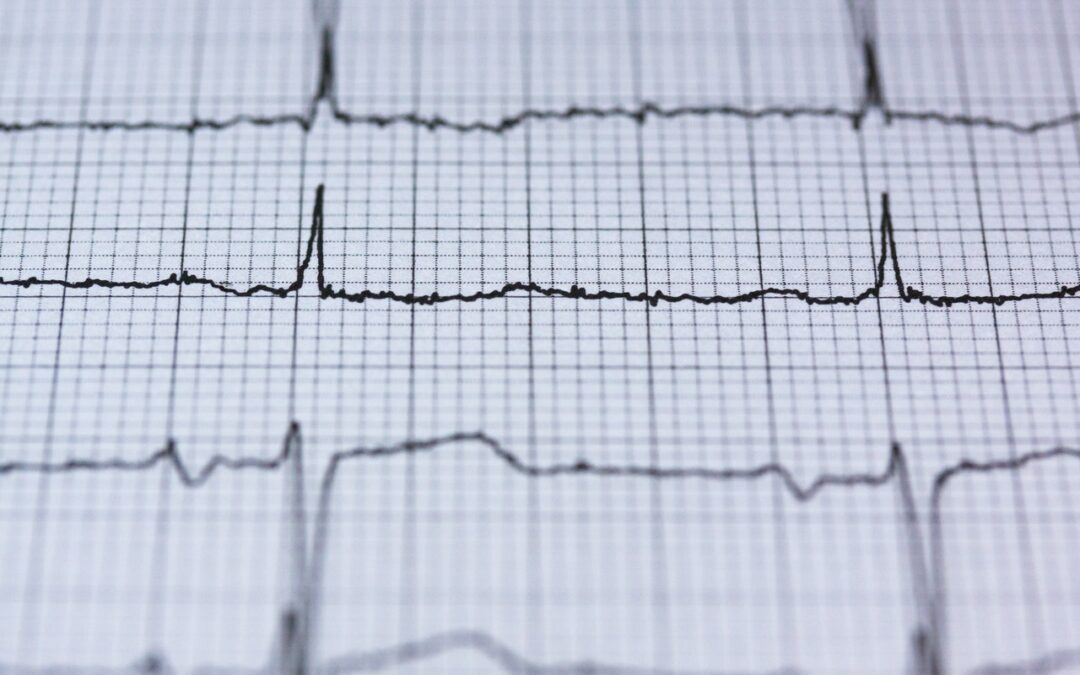
by Kirsten Chesney | Sep 29, 2020 | Chronic Health Conditions, Wellness Foods
You probably don’t know that today is World Heart Day. No, not the Valentine-type heart. World Heart Day is about lifting awareness of cardiovascular disease prevention, treatment, and risk factors. More common knowledge than World Heart Day might be the fact that heart disease remains the number one killer in the United States, accounting for one-quarter of all deaths. But heart disease is just one segment of what we’re talking about. In addition, stroke, heart attack, coronary artery disease, high blood pressure, and congestive heart failure are all types of cardiovascular disease or CVD. When taken together, a little less than half of all Americans (48%) have CVD! This is a serious issue that has grown into a staggering statistic. It’s also a great reason to raise awareness during World Heart Day (and every day for that matter).
CVD is caused by a number of factors but is mainly driven by our diet and lifestyle choices. Typically, CVD is associated with a buildup of fatty deposits inside our arteries (called atherosclerosis), which cause a cascade of deteriorating health effects leading to CVD. What we eat determines the health of our arteries such that our diet makes the greatest impact on the outcome of our health. Luckily, our diets are well within our control, meaning the risk of developing CVD is not inevitable. There is an aspect of food and cardiovascular health that has recently emerged in research but hasn’t gained much popularity. This new research is about fasting and has shown striking improvements for those at risk for CVD.
How Fasting Improves Heart Health
Among the several benefits of fasting is the lowering of risk factors for CVD. In fact, the researcher who designed the fasting mimicking diet, Dr. Valter Longo, discovered that those at high risk for CVD can be greatly helped by cyclical fasting. The fasting mimicking diet is safer and easier to follow than doing a complete fast. For those at risk for CVD, the benefits of fasting include:
- Reduced belly fat and waist circumference
- Decreased inflammation markers
- Reduced LDL cholesterol
- Lowered triglycerides
- Lowered blood pressure equivalent to what is seen with blood pressure medication
- Decreased fasting glucose
Need we say more? The fasting mimicking diet is a type of intermittent, prolonged fasting that lasts for 5 days. During this time, calorie-controlled nutrients and supplements are taken in small amounts so that your body can enter a fasted state while avoiding the discomfort of hunger. This allows a person to extend their fast for longer periods. Studies show that both the intermittent aspect of fasting (routine, cyclical), along with the prolonged time period (5 days), are what specifically leads to lower rates of CVD. Dr. Benjamin Horne, a researcher at the Intermountain Healthcare Heart Institute in Utah, points to a number of reasons why prolonged, cyclical fasting can lead to better heart health:
“Fasting affects a person’s levels of hemoglobin, red blood cell count, human growth hormone, and lowers sodium and bicarbonate levels, while also activating ketosis and autophagy—all factors that lead to better heart health and specifically reduce risk of heart failure and coronary heart disease.”
While there are several ways to follow an intermittent fasting schedule, it is recommended that people who have multiple risk factors for CVD to fast routinely about once a month until they achieve a healthy weight. Fasting can then be repeated 2-3 times per year to maintain heart health. Of course, your dietary diligence doesn’t only kick in when you’re fasting. Since maintaining heart health is a lifelong pursuit, then eating healthy must become a lifelong habit.
What to Eat When Not Fasting
So, you completed your routine fasting for this month and you can’t wait to eat a good meal. Great! But before making an impulse purchase in the checkout line (nothing of value is usually found here, edible or otherwise), let’s run through some guidelines to help keep you on track. Dr. Valter Longo, the researcher who developed the fasting mimicking diet, also developed a way of eating, coined the longevity diet. This diet not only lowers your risk for CVD but also allows you to age gracefully and live longer by replacing damaged cells with new healthy cells. In essence, Dr. Longo advocates eating more plants, healthy fats, less protein, and limited carbohydrates. Here is a breakdown of the components of the longevity diet, keeping in mind that those with sensitivities to gluten or nuts should modify this eating plan to suit their needs.
- No added sugar
- No red meat
- Limit poultry
- Limit dairy
- Fish
- Large amounts of organic vegetables
- Legumes, beans, and lentils
- Whole grains (including pasta and bread) but less than 100 grams per day
- Fruits, 1-2 per day
- Olive oil
- Nuts, one handful per day
Other considerations of heart-healthy eating are to confine all eating to 12 hours per day (between 7 am and 7 pm for example), and to limit two meals and two high-fiber snacks per day for overweight individuals. Lastly, this is a low protein diet. It is recommended that a person eat approximately 0.33 grams of protein per pound of body weight per day. This is about 50 grams of protein for a 150-pound person, and 60 grams of protein for a 180-pound person. As a reference, one serving of meat is approximately 40 grams of protein.
Why are we limiting protein? Research has shown that a high animal protein diet was positively associated with cardiovascular death, whereas protein from plant sources was negatively associated with death from all causes. This points out the importance of knowing the source and quality of your protein!
Despite the large amount of evidence for cyclical fasting and the prevention of CVD, more research is needed in larger clinical trials as scientists work toward FDA approval. In the meantime, these results are certainly promising and are appropriate to discuss with your doctor as an integrative strategy. Fasting is not for everyone, however. Those who are underweight, pregnant, nursing, or have certain health conditions should not try a fasting diet. Also, keep in mind that medications for high blood pressure should not be taken while fasting unless it is determined that your blood pressure will not drop below normal.
In recognition of World Heart Day, we bring to light some new findings that support repeated or routine fasting for the prevention of cardiovascular disease. This, coupled with a whole foods diet low in protein and rich in vegetables and healthy fats can be an effective way to reduce risk factors for CVD. Not only will this style of eating and fasting provide lifetime benefits for your heart, but it also supports a long and healthy life by slowing disease progression and restoring vitality. Talk with our team at CustomCare Nutrition to learn more about the fasting mimicking diet and the longevity diet!

by Kirsten Chesney | Jul 24, 2020 | Chronic Health Conditions
So you’re being treated for a digestive disorder and are learning a lot about how all the anatomy works (perhaps even more than you cared to know!). Or perhaps you aren’t sure what you have but you’re struggling with a myriad of digestive symptoms such as chronic constipation, bloating, vomiting, nausea, or upper abdominal pain after eating. Digestive disorders and digestive symptoms often have a common thread among them that is easily treatable.
One aspect of our digestive system is very important but rarely gets the attention it should. What I’m talking about has likely played a large roll in the development of your digestive concerns in the first place. What is this important topic? Motility.
Motility is simply the movement of your digestive organs that brings food down, through each stage of digestion until it is eliminated. Specifically, motility is the muscular movements and contractions of your esophagus, stomach, small intestine, and large intestine.
Migrating Motor Complex (MMC)
When motility occurs in the stomach and small intestine it is part of what’s called the “migrating motor complex (MMC).” This complex moves (or migrates) food down the digestive tract using muscular contractions (motor) in a cyclic pattern. This pattern of contractions only occurs while fasting, sleeping, or when there’s a long enough time between meals.
The MMC begins moving food down 1.5 to 2 hours after we eat and takes approximately an hour and 45 minutes to complete the entire phase. This process is interrupted as soon as you eat food!
When the nerves or muscles of digestive organs are not working properly, motility is stalled and people can suffer from a range of symptoms as well as digestive disorders:
Symptoms of Impaired Motility
Indigestion or heartburn
Bloating
Severe constipation
Recurrent vomiting
Digestive Disorders Associated With Impaired Motility
Esophagus:
Gastroesophageal Reflux Disease (GERD)
Dysphagia
Achalasia (swallowing disorder)
Functional Chest Pain
Stomach:
Gastroparesis (delayed gastric emptying)
Dumping Syndrome (rapid gastric emptying)
Indigestion
Cyclic Vomiting Syndrome
Small Intestine:
Intestinal Dysmotility
Small Intestine Bacterial Overgrowth (SIBO)
Large Intestine:
Constipation
Diarrhea
Irritable Bowel Syndrome (IBS)
Rectum:
Fecal incontinence
Hirschsprung’s Disease (megacolon, unable to pass stool)
Outlet Obstruction Syndrome (straining muscles fail to relax)
MMC and SIBO
We blog a lot about SIBO on this site, so it deserves a special mention as it relates to the migrating motor complex (MMC). As we learned, the MMC is the cyclic contractions of the stomach and small intestine that pushes food through our digestive tract. When this process is disrupted, it can cause intestinal dysmotility over time. This impaired motility plays into the severity of SIBO symptoms such as diarrhea, abdominal pain, and bloating.
Secondly, when your small intestine is not having its regular MMC contractions, food (and bacteria) become stagnated in place and the risk of bacterial overgrowth (SIBO) increases dramatically. Thus, the MMC not only controls the motility of food through our system, but it also acts as an intestinal housekeeper, controlling bacterial growth in our small intestine by migrating it towards our large intestine where it should be. Therefore, it is critical to correct any impaired motility as part of your SIBO treatment.
How to Promote Healthy Motility
Motility regulation should be part of any treatment for digestive disorders. Anybody with SIBO, IBS, bacterial overgrowth, constipation, or very slow transit time of food through the gut, can benefit from the stimulation of healthy motility.
Prokinetics:
There are several ways to induce motility and promote our MMC to having regular contractions. One way is to take a prokinetic. Prokinetics are supplements or medications that promote motility and help manage associated symptoms.
Prokinetic medications have several unintended side effects, specifically affecting mood, digestive discomfort, sleep quality, energy levels, and appetite.
Prokinetic supplements are herbal remedies that have been long used to promote gut motility. Some examples of prokinetic herbs are: ginger, milk thistle, lemon balm, peppermint, licorice root, ginseng, and various herbal fruits and dried roots. Prokinetic supplements are usually proprietary blends of several herbs. They work together to activate contractions of the gut muscles, speed up stomach emptying, and act as anti-inflammatory agents. Prokinetics also provide relief for multiple digestive symptoms.
Make sure to talk with our team at CustomCare Nutrition to ensure you are taking the right prokinetic and at the right time in your treatment schedule.
Stress Management:
Another way to promote healthy motility is to reduce your stress levels. Stress disrupts many of our body’s normal processes, including digestion. Chronic psychological stress slows digestion and can lead to constipation and a slowed MMC. Relaxation techniques help lower our stress levels. Try meditation, deep breathing, and yoga or gentle stretching to ease your stress.
Meal Spacing:
As we learned, the MMC is activated by having an empty stomach. MMC contractions take place 1.5 to 2 hours after we eat, as well as overnight. The whole process lasts for an hour and 45 minutes, provided that food is not eaten during this time! To give your MMC the best chance at doing its job, its best to wait at least 3 hours and 45 minutes between meals/snacks. Any food eaten within this time frame will disrupt your MMC. Most beverages will also disrupt this process, however black coffee, herbal teas, and water, are all okay to have between meals. This can be a difficult habit to adopt, but it will work wonders for your digestion! When practicing meal spacing, it’s best to eat nutrient-dense meals that won’t leave you hungry in an hour. Eating only grains (like cereal or toast for breakfast) will not be filling enough and you’ll be ready for a snack soon after. Instead, maximize each meal by including healthy fat, protein, and high-fiber vegetables. This will create long-lasting satiety (fullness) for several hours without feeling the need to snack.
Not everyone should practice meal spacing, however. Infants, children, and pregnant women should eat more frequently to meet their growing nutrient needs. Those with diabetes are also excluded as they usually need to eat more often to balance their blood sugar.
Overnight Fasting:
Our MMC not only works between meals on an empty stomach. It also works overnight while we are sleeping. For this reason, a 12 hour overnight fast will allow our MMC to work effectively without regular food interruptions. An example of a 12 hour overnight fast would be to finish eating dinner at 7-8 pm, going to sleep, and then eating breakfast between 7-8 am the next morning. This is not an unusual routine for most people, so you might find that going 12 hours with overnight fasting isn’t difficult to achieve.
Motility and the actions of our MMC play a crucial role in our digestive system. They ensure that the food we eat gets moved through our GI tract at the proper speed, which in turn prevents bacteria from stagnating in one place and causing an overgrowth. Having proper motility will prevent (and treat) digestive disorders, like SIBO, as well as a myriad of GI symptoms such as constipation, bloating, and abdominal pain. Prokinetic supplements are herbs that activate motility in our gut and are useful for treating digestive disorders. Stress management, meal spacing, and overnight fasting are other ways we can promote healthy motility. Talk to our team at CustomCare Nutrition on how your motility might be paying a part in your digestive symptoms!

by Kirsten Chesney | Feb 2, 2020 | Chronic Health Conditions
GERD, or gastroesophageal reflux disease affects about 40% of American adults at least once per month. GERD is when stomach acid escapes upward into our esophagus, where there is no protective layer, and causes acid damage. GERD invites symptoms of, heartburn, regurgitation, chronic coughing, difficulty swallowing, and/or dental erosions. If left unchecked, GERD can cause constriction of the throat, scarring, ulceration, and even cancer of the esophagus.
The Problem With GERD Medications
Unfortunately, drug companies are not looking to figure out why stomach acid isn’t staying in the stomach. Instead, they assume GERD is a problem of too much stomach acid, and so have developed a line of acid-suppressing drugs, like PPI’s and H2 blockers. Like most other medications, GERD medications serve to merely suppress the symptoms of GERD even as the underlying cause of the problem continues to occur in our bodies, stripping us of optimal health and vitality.
So, It’s Not About Too Much Stomach Acid?
When we look at research, we see that the risk for developing GERD increases as we age. However, our production of stomach acid actually decreases with age. This means people statistically have low stomach acid by the time they develop GERD, so how can it be caused by too much acid?
Secondly, studies have shown that GERD patients respond very well when they supplement with HCl (hydrochloric acid, or stomach acid), which serves to increase their stomach acid.
Lastly, stomach acid is a natural production of our bodies. We need stomach acid to kill pathogens found on our food, thus protecting us from a bacterial or viral infection. Stomach acid also breaks down food and activates enzymes that digest carbs, fats, and proteins. Interestingly, our bodies also have a failsafe against stomach acid getting too high: we produce bicarbonate, a base, which neutralizes acid and ensures the correct pH in our stomach.
Now we can see the valuable purpose of stomach acid and how lowering it can harm our digestion and increase our risk for infection.
The Real Cause of Gerd:
If it’s not about too much stomach acid, then what is the real cause of GERD? Studies show that it is caused by an increase in pressure against the muscles at the end of our esophagus (where it meets our stomach). These muscles are called the lower esophageal sphincter (LES) and they are designed to prevent the contents of our stomach from traveling upwards. The only times when the LES should be open is when we are swallowing or burping.
When there is too much pressure pressing against the LES, the sphincter relaxes and opens up when it’s not supposed to. This is when GERD becomes a problem.
What Causes This Increased Pressure?
Recall the two main purposes of stomach acid: protecting our digestive system from harmful bacteria and activating enzymes that digest our food (such as carbs). Keeping this in mind, therefore:
Low stomach acid thus allows bacteria to survive through the stomach and make their way into our intestine. This can cause chronic gut infections and increase the pressure against our LES, causing the sphincter muscles to weaken and GERD to occur.
Low stomach acid also thus cannot signal enzymes to digest carbs properly. Undigested carbs are fermented by the normal gut bacteria in our intestine, and, if in excess, this fermentation generates too much hydrogen gas. Too much hydrogen gas, again, increases the pressure pressing against our LES.
How to Treat Gerd Without Medication:
The good news is that GERD can be treated and reversed without resorting to medication. This is done through replenishing low stomach acid, addressing any bacterial infections, reestablishing good bacteria in our gut, and preventing excess fermentation of carbohydrates.
–Increase your stomach acid: Supplement with one capsule of “HCl with pepsin” at the beginning of each meal. Two days later, increase to two capsules before each meal. Two days after that, increase to three capsules.
Continue increasing until you feel a slight burning sensation, then back off by one capsule. This is your “sweet spot” of how many capsules you need to take before each meal. Do not exceed 6 capsules per meal.
–Avoid NSAIDs: Ibuprefen, aspirin, and other NSAIDs can increase your risk of acid-related disorders as well as cause damage to the gut lining. Further, taking any anti-inflammatory medication concurrently with an HCl supplement, described above, can increase your risk of ulcers or gastric bleeding.
–Avoid drinking water during meals: this dilutes stomach acid and hinders digestion.
–Treat any bacterial infection or bacterial overgrowth: Low stomach acid invites bacterial infections and/or bacterial overgrowth (such as an H. pylori infection and SIBO). If you suspect this is happening, seek specific treatment, resources, and guidance with CustomCare Nutrition. Treatment will involve a specialized carb diet, antimicrobial supplements, motility agents, and sometimes antibiotics.
–Take probiotics: Probiotics are our healthy bacteria in our gut, which can become compromised due to low stomach acid. Taking probiotics can reduce bacterial overgrowth, protect against harmful bacterial strains, and normalize our digestive process.
–Eat a low-carb diet: Low stomach acid affects your ability to digest carbs properly. Decreasing the amount of carbs you eat will lessen the frequency of fermentation of undigested carbs and resulting hydrogen gas build-up. Focus on nutrient-dense, whole food rather than low-carb processed foods.
The causes of GERD are more complex than originally assumed and purported by drug companies. Furthermore, lowering our stomach acid in the hopes of suppressing symptoms will only invite a host of even more symptoms. Instead, GERD must be treated through addressing the underlying cause. This is the only way our bodies can truly heal and regain full functionality!

by Kirsten Chesney | Nov 18, 2019 | Chronic Health Conditions
A person does not have to have Celiac Disease to experience the negative effects of eating gluten. Non-Celiac gluten sensitivity (NCGS) is when people experience an array of symptoms after eating gluten, but without the intestinal damage that is seen in those with Celiac. It is thought that 18 million Americans have gluten sensitivity, six times greater than the number of Americans with Celiac Disease.
How Does Eating Gluten Trigger Brain Changes?
The most common symptoms of gluten sensitivity are related to the digestive tract and include constipation, diarrhea, and bloating. However, gluten sensitivity can also affect the brain and mental health. The connection between the digestive tract and the nervous system is called the gut-brain axis. In essence, our diets affect our microbiome, whether positively or negatively. Eating gluten, for those who are sensitive, alters the ecosystem of our “gut bugs,” thus causing inflammation in the gut, affecting our enteric nervous system (the nervous system in our digestive tract). The gut-brain axis communicates changes from the enteric nervous system to our central nervous system (our brain and spinal cord). In this way, inflammation in our gut can cause inflammation in our brains. This is called neuroinflammation.
What Neuroinflammation Can do to Your Brain
Neuroinflammation plays a role in cognitive impairment and the development of ADHD, depression, anxiety, schizophrenia, bipolar disorder, and even autism. It also increases our risk of developing neurodegenerative diseases like Parkinson’s and Alzheimer’s.
How to Decrease Neuroinflammation and Manage Neurologic Symptoms
In order to reduce the effects of neuroinflammation, or if a person is experiencing any of these mental and cognitive disorders, it is important to restore the health of the gut-brain axis:
— Follow a strict gluten-free diet:
— Restore the microbiome (gut bacteria) by taking probiotics and prebiotics
— Reduce inflammation by eating anti-inflammatory foods (see a recent post about which foods are anti-inflammatory)

by Kirsten Chesney | Nov 12, 2019 | Chronic Health Conditions
We all know diabetes is becoming more and more prevalent among Americans. Today, 10% of Americans have type 2 diabetes, with 25% of Americans falling into the pre-diabetes range. Those with prediabetes are projected to develop diabetes within five years if no treatment or preventative measures are taken. Once called “adult-onset” and reserved for higher-class populations, diabetes is now striking adolescents and is heavily seen in middle and lower-class populations. This shift is attributed to the declining nutritional value of the Western diet and its cheap and easy access by all Americans. Diabetes is also connected to being sedentary, getting poor sleep, having chronic stress, and being exposed to an overload of environmental toxins.
Two Approaches to Treating Diabetes
The conventional approach towards diabetes is a hands-off approach until a person actually becomes diabetic. Little is done during the pre-diabetic stage in terms of nutrition education, healthy habit formation, dietary changes, and overall healthy lifestyle habits. Secondly, the traditional dietary guidelines for those with diabetes are outdated and focus too heavily on carbohydrates while downplaying the role of healthy fats. Lastly, diabetes drugs do not address the core reason this disease developed originally. Medications address the downstream outcome of the problem, rather than the upstream source of the problem. Diabetes drugs also come with an array of nasty side effects, the least of which is kidney and liver dysfunction.
In contrast, the functional medicine model explores all aspects of a person and addresses the root cause behind disease development. Preventative measures are taken, including nutrition education and healthy habit formation. When approached in this way, diabetes and pre-diabetes can be improved, well-managed, and even reversed.
The Functional Medicine Model For Diabetes
Diet
Dietary changes are at the center of diabetes management and treatment. Carbohydrates should be limited each day to about 15% of total calories. The type of carbohydrate also matters. High-fiber, whole-food vegetables should compose most of your carbohydrate intake, supported by whole-fruits, whole-grains, and full-fat dairy (if tolerated). Pairing a carbohydrate with a healthy fat or protein will help decrease glucose spikes and insulin levels after a meal.
Functional medicine recognizes the impact that gluten can have, especially in those with chronic conditions. Gluten increases intestinal permeability, creates inflammation, and thereby can lead to insulin resistance. Avoiding gluten is, therefore, a common treatment plan for those with diabetes or pre-diabetes.
Exercise
Getting physical activity does not mean intense training or long hours at the gym. Preventing and managing diabetes can be accomplished with 30 minutes of exercise a day. Aerobic activity, like jogging biking, or swimming, is the most effective type of exercise for lowering blood sugar.
Look for ways to interrupt a sedentary lifestyle each day. Take regular breaks every hour to walk around the office, give office memos or messages in-person rather than paging them, convert your desk into a standing desk, or otherwise look for ways to break up your day by moving.
Sleep
Most Americans do not get enough sleep, and studies are now showing that getting less than 7-8 hours of sleep each night is actually a risk factor for developing type 2 diabetes. Secondly, those with sleep apnea are at greater risk for diabetes due to the lack of oxygen that occurs while sleeping. For proper sleep hygiene, aim for getting 7-8 hours of sleep each night, avoid eating between dinner and bedtime, and limit the blue light emitted from electronic screens 2 hours before going to bed.
Stress
Another risk factor for diabetes is chronic stress. Stress hormones, if continuously activated overtime, cause blood sugar imbalances, beta cell dysfunction, and insulin resistance. Ways to reduce stress include meditation, deep breathing, visualizations, and yoga. These practices can decrease blood sugar levels in those with diabetes.
Environmental Toxins
The accumulation of environmental toxins in our bodies contributes to the development and progression of many chronic diseases including type 2 diabetes. Some of the main culprits include BPA, phthalates, pesticides, and PCB’s. Reducing your exposure to environmental toxins can be as straight-forward as replacing plastic food storage and water bottles with glass, buying phthalate-free personal care products, focusing on organic produce by avoiding the “Dirty Dozen,” and filtering your tap water.
Type 2 diabetes is an ever-growing health concern in America. The conventional medical model focuses on symptom management without addressing underlying causes. Functional medicine treats the underlying cause and can improve and even reverse diabetes through nutrition and lifestyle changes. Ask us how you can get started on our diabetes program today!





